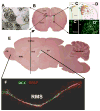Ischemic stroke and neurogenesis in the subventricular zone
- PMID: 18632119
- PMCID: PMC2562038
- DOI: 10.1016/j.neuropharm.2008.05.027
Ischemic stroke and neurogenesis in the subventricular zone
Abstract
The subventricular zone (SVZ) of the lateral ventricle contains neural stem and progenitor cells that generate neuroblasts, which migrate to the olfactory bulb where they differentiate into interneurons. Ischemic stroke induces neurogenesis in the SVZ and these cells migrate to the boundary of the ischemic lesion. This article reviews current data on cytokinetics, signaling pathways and vascular niche that are involved in processes of proliferation, differentiation, and migration of neural progenitor cells after stroke.
Figures

 in C and D) and neuroblasts (
in C and D) and neuroblasts (
 in C and D) in the SVZ of the right lateral ventricle of non-ischemic (C) and ischemic (D) hemispheres as well as a corresponding view of neuroblasts identified by doublecortin (DCX) positive cells (C′ and D′, green). Neuroblasts in the SVZ (C and C′ green) migrate through the rostral migratory stream (RMS, E and F, green color) into the olfactory bulb (OB, E and F, green color). However, after stroke, many neuroblasts in the SVZ migrate towards the ischemic striatum (D and D′, green color). Red color in panel F is GFAP positive astrocytes. CC = corpus callosum and DG = dentate gyrus.
in C and D) in the SVZ of the right lateral ventricle of non-ischemic (C) and ischemic (D) hemispheres as well as a corresponding view of neuroblasts identified by doublecortin (DCX) positive cells (C′ and D′, green). Neuroblasts in the SVZ (C and C′ green) migrate through the rostral migratory stream (RMS, E and F, green color) into the olfactory bulb (OB, E and F, green color). However, after stroke, many neuroblasts in the SVZ migrate towards the ischemic striatum (D and D′, green color). Red color in panel F is GFAP positive astrocytes. CC = corpus callosum and DG = dentate gyrus.

References
-
- Ahn S, Joyner AL. In vivo analysis of quiescent adult neural stem cells responding to Sonic hedgehog. Nature. 2005;437:894–897. - PubMed
-
- Alvarez-Buylla A, Lim DA. For the long run: maintaining germinal niches in the adult brain. Neuron. 2004;41:683–686. - PubMed
-
- Alvarez-Buylla A, Garcia-Verdugo JM, Tramontin AD. A unified hypothesis on the lineage of neural stem cells. Nat Rev Neurosci. 2001;2:287–293. - PubMed
-
- Androutsellis-Theotokis A, Leker RR, Soldner F, Hoeppner DJ, Ravin R, Poser SW, Rueger MA, Bae SK, Kittappa R, McKay RD. Notch signalling regulates stem cell numbers in vitro and in vivo. Nature. 2006;442:823–826. - PubMed
-
- Anthony TE, Klein C, Fishell G, Heintz N. Radial glia serve as neuronal progenitors in all regions of the central nervous system. Neuron. 2004;41:881–890. - PubMed
Publication types
MeSH terms
Grants and funding
LinkOut - more resources
Full Text Sources
Medical

